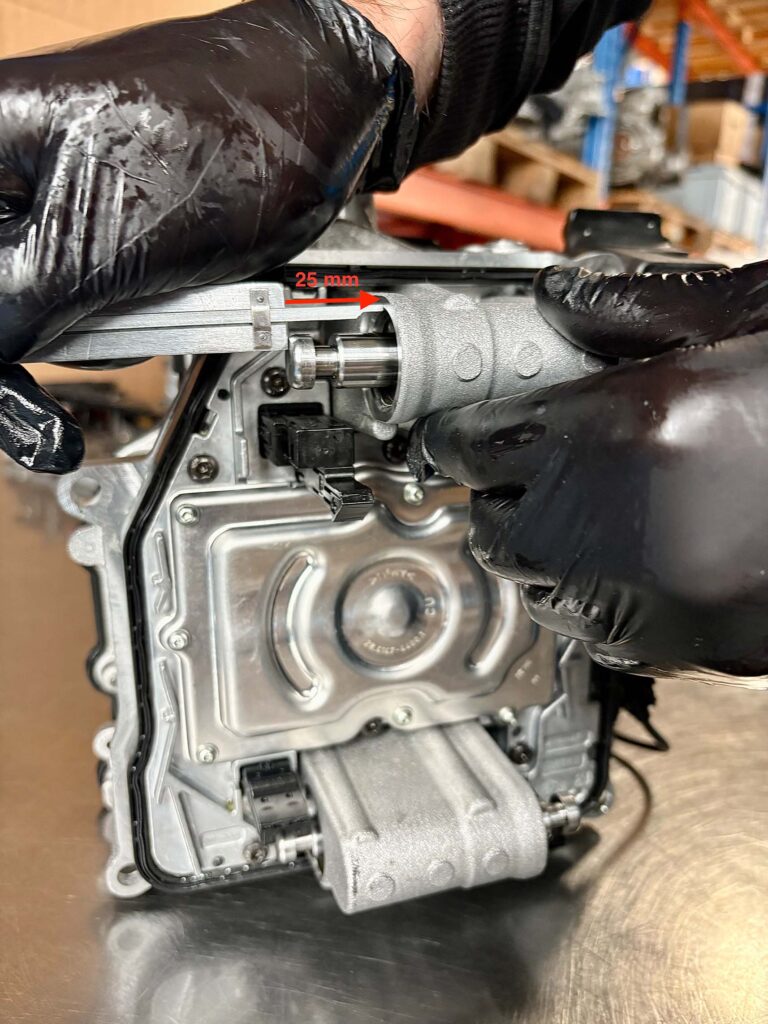When installing the DQ200 mechatronics, mistakes often occur that lead to functional limitations or even damage. New or repaired mechatronics are often installed “by trial and error” or using improvised measuring methods - which in most cases does not yield a reliable result. Even pre‑positioning the gearbox into neutral via diagnostic tools is often considered a safe method - in practice however it rarely works well.
In principle, the installation is simple if you proceed systematically. Below is a brief guide:
Step 1: Adjust the plungers (actuators) |
Step 2: Gearbox‑side check |
|
|
|
|
First, the plungers of the mechatronics unit must be set to a length of 25 mm.
|
On the gearbox side, you must also check whether all shift forks are in the neutral position. |
Step 3: Install the mechatronics unit
If both the gearbox and the mechatronics unit are correctly prepared, the mechatronics can be carefully inserted into the gearbox. During this process, the manufacturer's specifications must be followed, for example torque values and the amount of oil. After installation, a basic adaptation (initialization) via diagnostics tester is required.
A detailed instruction for this is available [here - link].
If the adaptation process fails, corresponding error codes will appear in the diagnostic system. You are welcome to send them to us - we’ll help you identify the cause.
FAQ: DQ200 Mechatronics
1. Can I install the DQ200 mechatronics myself?
In principle, yes — but it requires technical expertise, special tools, and precise adjustment of plungers and neutral position. Anyone without experience with DSG gearboxes should have installation done in a specialist workshop. Also, check warranty conditions.
2. What happens if the mechatronics is installed incorrectly?
Incorrect installation can result in shifting issues, malfunctions, or even damage to the gearbox and mechatronics. Particularly dangerous are incorrect plunger adjustments or improperly positioned shift forks.
3. How can I tell whether the gearbox is in neutral position?
In the DQ200, there are seven forward gears and one reverse gear. Each shift fork moves a gear left or right; the middle position corresponds to neutral — this position must be precisely verified before installation.
4. Is a basic adaptation required after installation?
Yes — after each installation or replacement of the mechatronics, a basic adaptation using a diagnostic tester is absolutely required. Only then are clutch and shift values correctly learned.
5. Which error codes may appear after installation?
Common error codes following a faulty adaptation include e.g. “Gear X — not adjustable.” These often point to an incomplete or aborted initial adaptation. In such cases, we are happy to assist you with the error analysis.
6. Are there differences in the installation between a new and a repaired mechatronics unit?
No — the steps are fundamentally the same. However, with repaired mechatronics units you should pay extra attention to clean connector contacts and correct plunger dimensions.
7. Where can I find the official manufacturer specifications?
The respective torque values, oil fill levels, and tightening specifications are stored in the original documentation from Volkswagen. We recommend creating an account in the VAG group’s information system. There you can access and print a vehicle‑specific repair manual (for a fee). Below are some useful links per brand:



